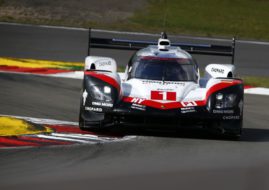Porsche 935 - Outstanding Car of Enormous Power
From the very beginning of Porsche’s sportscar manufacturing, the brand has always been oriented towards racing. Although initially this was limited to an amateur level, soon Porsche entered the highest ranking championship series with innovative cars and a technical edge over its competitors. During the ’60s, Porsche was very active in Formula One, rally championships and endurance racing, the highlight of which was the epic 1970 24 Hours of Le Mans win in the legendary Porsche 917.

Porsche 935
New technology for already successful 911
However, Porsche’s main product, the 911, was not the main focus of the factory’s racing efforts. Of course, it started racing and winning right from the time it was introduced, but the first factory racing car or homologation special was Carrera RS 2.7 from 1973. It proved to be very successful and with the introduction of the next generation of 911 in 1975 (factory code ‘930’), Porsche wanted to go a step further and introduce new technology into the racing scene. The biggest news from Porsche came in 1975 when it introduced the 930 Turbonot the first turbocharged car in the world, but definitely the fastest and most interesting one. It combined a lightweight, new and sleek body with new technology and big power. Of course, there was a big turbo lag and overheating problems but all of that was a small price to pay for enjoying the world’s most advanced sports car of the time.

Porsche 935 cutaway
Enormous power and big fenders
The factory realised the enormous potential of the new model and very quickly started developing a racing version with a turbocharged engine. Porsche had some experience with turbocharged racing cars from its Can-Am racing, but packing such power into a 911 bodyshell was a different story. In 1977, the Porsche 935 was introduced. At first, it was offered to private teams which competed in sports car championships alongside the Porsche-Martini factory team. The Porsche 935 soon started participating in the Groupe 5 series along with the BMWs and Jaguars. The Groupe 5 regulations in those days were more relaxed and allowed engineers to change the appearance and construction of the cars. Thus, the 935 soon got big wings, big fenders and its famous ‘Flachbau’ or flat nose design of the front end which become highly popular and even appeared on some of the road cars in the ’80s.

Porsche 935 Flatnose
Beneath the body kit, enormous spoilers and fenders there was a lightweight 930 aluminium chassis, full racing suspension and the famous 6-cylinder box motor with 2.9 liters displacement. The FIA rules asked for sub 4-liter displacement, so Porsche was well under the limit even with the 1.4 equivalency factor given to turbocharged engines.

Porsche 935 engine
However, the power of this engine was outstanding. The factory rated the 935 racing cars at 580 bhp, but depending on the boost and settings, the engine was capable of producing up to 900 bhp! Because of the enormous lag and primitive turbo technology, the cars were very difficult to drive and every time the accelerator pedal was pressed, it was followed with fire spitting from the exhaust. Some say that a couple of the racing 935s even had some bodywork melted from the exhaust fire!

Porsche 935
The factory made four versions with the first being the 935/77A customer’— an early model intended for private teams, the second was the 935/77 works— a factory race car, and the third was a ‘935/77 2.0’ — a smaller engined 935 with 2.0 boxer and “only” 370bhp.

Porsche 935/77
The ultimate “Moby Dick” version
Those cars all looked the same, but the fourth version was very different and featured modified bodywork with a longer rear end, a bigger spoiler and very strange design. It was called 935 ‘Moby Dick’ because it looked like a whale, especially when it was painted white. The ‘Moby Dick’ was a crowd favorite and was introduced in late 1978. The strange rear end was aerodynamically correct because the cars developed high speeds and needed better stability.

Porsche 935 Moby Dick
The performance was outstanding935’s racing career lasted from 1976 to 1980 during which time this Porsche won almost half of all the races it entered, a fantastic achievement to say the least. It won the 1979 24 Hours of Le Mans, the 24 Hours of Daytona, the 12 Hours of Sebring and many more. It was a very popular choice in the Group 5, GTP, and GTX racing both in Europe and North America in the hands of private drivers and factory-backed teams.
Photo: autowp.ru






